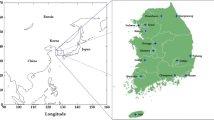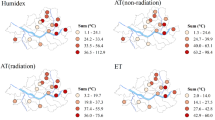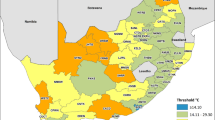Abstract.
Previous research has noted that high surface temperatures within certain “offensive” air masses can lead to increased mortality. This study assesses the relationship between daily mortality rates and weather within the city of Shanghai, China, while introducing an operational heat/health warning system for the city. Using numerous meteorological observations, the spatial synoptic classification has been used to classify each summer day from 1989 to 1998 into one of eight air mass types for Shanghai. Through the comparative analysis of the daily air mass type and the corresponding Shanghai mortality rate, “moist tropical plus” (MT+), an extremely hot and humid air mass, was identified as an offensive air mass with the highest rates of mortality. Using stepwise regression, an algorithm was produced to help predict the number of excess deaths that will occur with each occurence of the MT+ airmass. The heat/health warning system was run experimentally in the summer of 2001 and illustrated that the use of a warning system can alert the city’s residents of potentially offensive weather situations that can lead to a deterioration in human health.



Similar content being viewed by others
References
He Q, He Z, Zhen Y (1990) An investigation about the impact of heat wave on human health in hot area (in Chinese). J Environ Health 7:206–211
IPCC (1995) Assessing the health impacts of climate change. Intergovernmental Panel on Climate Change Impacts Assessment. WMO/UNEP, Geneva, Switzerland
Kalkstein LS (1998) Activities with Study Group 6 of the International Society of Biometeorology, Int J Biometeorol 42:8–9
Kalkstein LS (1991) A new approach to evaluate the impact of climate on human mortality. Environ Health Perspect 96:145–150
Kalkstein LS, Greene JS (1997) An evaluation of climate/mortality relationships in large U.S. cities and the possible impacts of a climate change. Environ Health Perspect 105:84–93
Kalkstein LS, Nichols MC, Barthel CD (1996a) A new spatial synoptic classification: application to air mass analysis. Int J Climatol l16:983–1004
Kalkstein LS, Jamason PF, Greene JS, Libby J, Robinson L (1996b) The Philadelphia hot weather-health watch/warning system: development and application, Summer 1995. Bull Am Meteorol Soc 77:1519–1528
Nakai S, Itoh T, Morimoto T (1999) Deaths from heat-stroke in Japan: 1968–1994. Int J Biometeorol 43:124–127
Smoyer KE (1998) A comparative analysis of heat waves and associated mortality in St. Louis, Missouri – 1980 and 1995. Int J Biometeorol 42:44–50
Steadman RG (1979) The assessment of sultriness. Part II. Effect of wind, extra radiation, and barometric pressure on apparent temperature. J Appl Meteorol 18:874–884
Sun LY, Ren J, Xu SZ (1994) The impact of heat wave on mortality of residents in hot area (in Chinese). Meteorol Mon 20:54–57
Yang HQ, Chen ZH, Liu JA, et al (2000) Epidemiological analysis on heat invasion and establishment of its statistical forecast model in Wuhan (in Chinese). J Hubei Coll Trad Chinese Med 2:51–52, 62
Acknowledgements.
This work was supported by the WMO and WHO Showcase Project. We thank Dr. Paul Lianso (WMO), Dr. Carlos Corvalan (WHO) and Dr. Steve Tamplin (WPRO, WHO) for their excellent contribution to this project. We also thank Dr. Scott Sheridan for his cooperation while carrying out research at the University of Delaware.
Author information
Authors and Affiliations
Corresponding author
Rights and permissions
About this article
Cite this article
Tan, J., Kalkstein, L.S., Huang, J. et al. An operational heat/health warning system in shanghai. Int J Biometeorol 48, 157–162 (2004). https://doi.org/10.1007/s00484-003-0193-z
Received:
Accepted:
Published:
Issue Date:
DOI: https://doi.org/10.1007/s00484-003-0193-z




